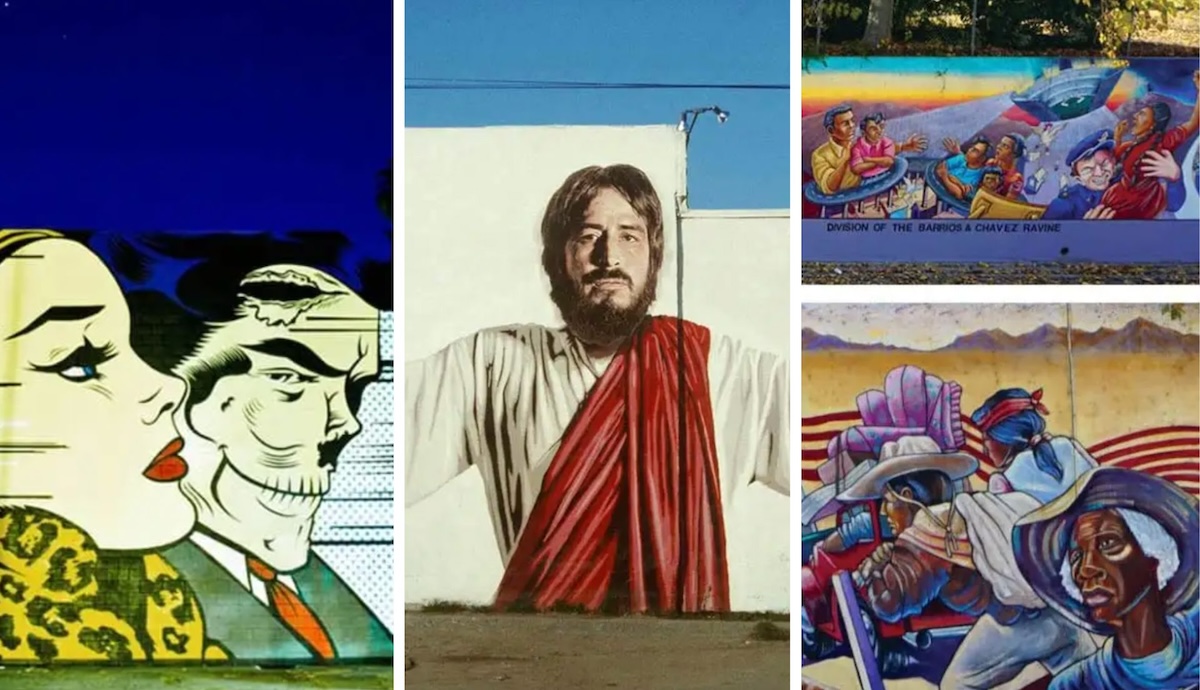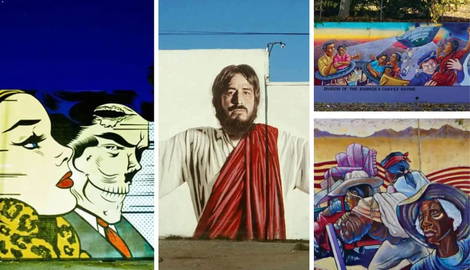
Painted house facades and city walls characterize the cityscape of Los Angeles. There is a long tradition behind these artworks, which already found their way into the cityscape of L.A. in the 1930s, and the pieces range from muralism to modern street art. The Mexican painter David Siqueiros was one of the first to bring this early form of street art from Mexico to the West of the USA with his work América Tropical (1932), and others soon followed suit. In the following decades, Los Angeles made a name for itself as the “Mural Capital of the World,” which it still lives up to today.
Murals and Street Art in Los Angeles: A Brief History

In his text Why do Graffiti Writers Write on Murals? The Birth, Life, and Slow Death of Freeway Murals in Los Angeles (2016), author Stefano Block examines the emergence of muralism in Los Angeles and the development of this street art from a form of artistic protest, especially by the Chicanos and against car-savvy urban politics, to a recognized art form. A turning point in the history of the murals, according to Bloch, was the 1984 Olympic Arts Festival: “By 1984, the 10 Olympic Arts Festival murals would emulate and, in a sanitized form, legitimize a vernacular form of expression and radical use of space conceived of by graffiti writers and members of the critical Chicano/a mural movement.” The following street art murals and their artists will examine the development of muralism in Los Angeles before, during, and after 1984.
1. América Tropical (1932) by David Alfaro Siqueiros: Pioneering Street Art

David Siqueiros’ mural América Tropical from 1932 not only represents the arrival of muralism as a form of street art in Los Angeles but also symbolizes the way the city of Los Angeles deals with this form of artistic protest. América Tropical was originally commissioned by the city of Los Angeles for the Plaza Art Center. The request was for “a festive work for the Mexican-themed tourist district, an exotic but playful piece that inspired and soothed”. This is how author Sarah Schrank describes it in her text The Art of the City: Modernism, Censorship, and the Emergence of Los Angeles’s Postwar Art Scene (2016).
Instead of the commissioned piece, Siqueiros created a mural painting “with images of severe native Stuart and an angry eagle,” which stands as a symbol for the Anglo-American occupation of Mexico. Due to its critical potential, the 80 x 18 ft mural soon fell victim to what many called whitewashing. It was only in the 2000s that the Getty Research Institute restored and conserved the mural and since 2012 it has been made visible to visitors again in an exhibition.

David Alfaro Siqueiros was a Mexican painter of social realism who became famous for his murals in fresco and who made muralismo great in Mexico together with Diego Rivera and José Clemente Orozco. While his murals are most famous in Mexico City, he got his start in Los Angeles, as América Tropical was his first outdoor mural. Siqueiros is remembered as one of Mexico’s most radical artists today – formally, painterly, and ideologically.
2. Siqueiros: La Voz De La Gente! (2012): A Tribute Mural

Just how important David Siqueiros’ influence was for the development of muralism as street art in Los Angeles can be seen in this unique mural. In 2012, various artists paid tribute to the Mexican painter by dedicating a mural painting to him entitled Siqueiros: La Voz de la Gente! The work was created in the context of Latin Heritage Month and was initiated by Anna Siqueiros, a great-niece of the famous painter. The piece was carried out as a collaborative work by various artists such as Ernesto de la Loza, Willie Herrón III, Carlos Callejo, Carlos Duran, Juan Carlos Muñoz, Fabian Debora, Raul Gonzalez, Nuke, Defer, Blossom, and more.
3. The Great Wall of Los Angeles (1976-83) by Judith Baca: Californian History

The Great Wall of Los Angeles (1976-83) is a mural that was designed by the artist Judith Baca and subsequently executed over many years by over 400 different volunteers and artists. The original title of this street art piece is The History of California. This mural is in many ways an exceptional piece of street art. The Great Wall of Los Angeles turned into a public project coordinated by the Social and Public Recourse Center (SPARC). Today, with a length of half a mile, the mural counts as one of the longest in the world.

The Great Wall of Los Angeles tells the history of California through the eyes of women and minorities. Judith Baca’s Chicano background also plays a major role in the motifs. Chronologically, the mural tells the history of California, starting with the dinosaurs. Most of it tells about the influence, oppression, and liberation of minorities in the city history of L.A. until the 1950s. Judith Baca is a Chicano artist, activist, and co-founder of SPARC. The Great Wall of Los Angeles is her most famous project. The mural has been damaged over the decades, but it has been restored and is even planned to be continued in the future.
4. Ignorance And Poverty (1970-76) by Elliot Pinkney: Murals Of Protest

The murals of the artist Eliot Pinkneys depict a piece of African-American protest and history in the form of street art. The work Ignorance and Poverty (1970-76) has become an iconic L.A. mural. Author Michael Fallon interprets the wall painting with a two-headed snake and a central heroic figure symbolically holding an eyeball in his hand, saying, “Perhaps created as a way of coping with the realities of his changing community, Pinkney’s painting was heavily didactic, but the artist compensated for this didacticism by employing the vibrant color, boldly emblematic shapes, and the dynamically flowing, twisting composition that local Chicano muralists had developed a few years earlier.” (see Creating the Future: Art and Los Angeles in the 1970s)
Originally coming from the Chicano culture and art, muralism has become a pictorial means of expression in public space for other minorities over the decades in Los Angeles as well. Elliot Pinkney’s murals are among the most famous mural works by African Americans.
5. Seventh Street Altarpiece (1983-84) by Kent Twitchell: Freeway Murals

According to author Stefano Block, the construction of massive freeways in Los Angeles has always been demonized by some and praised by others as admirable design work or even as a cathedral of time and place. In the spirit of the latter admiration, the mural artist Kent Twitchel created his Seventh Street Altarpiece, commissioned by LAOOC and the Olympic Arts Festival, in 1983 and 84, appearing in two 18 × 97ft sections on opposite sides of the 110 Freeway in downtown Los Angeles.

Bloch describes these murals evocatively, saying, “One side of the diptych depicts artist Lila Albuquerque, hands open to either side of her face with palms facing outward. The other side portrays artist Jim Morphesis, in the same pose, same disinterested stare, the same larger-than-life photorealistic headshot. As the most prolific muralist in L.A., both in terms of the size of his murals and the number produced, Twitchell also experienced the most praise for and existential challenges to his work.”

Realistically painting famous people and stars– not photo-realistic ways as the artist claims – has become Kent Twitchell’s trademark over the decades. His mural Seventh Street Altarpiece was destroyed over the years and then brought to the 101 freeway. There, the work fell victim to various graffiti tags. Today the tagged mural is a symbol of an idealistic fight and quarrel in the understanding of street art. The destruction of his two mural artworks led Kent Twitchell judge later, saying, “The mural capital of the world has become the graffiti capital.” (Twitchell, personal interview, 2013)
6. Going Nowhere Fast (2012) by D*Face: Comic Street Art

While Kent Twitchell is known for his photorealistic murals, the murals of street art artist D*Face are all about comic style and Pop Art. D*Face belongs to a new generation of muralists whose murals can be seen all over the world. Some of them shape the cityscape of Los Angeles. The murals of D*Face in L.A. often have a cinematic, dramatic character that is fitting to Hollywood, as the mural Going Nowhere Fast (2012) shows.

Another mural entitled Rear View (2014) deals with the image of Los Angeles as a car city. Unlike his predecessors, the British artist D*Face alias Dean Stockton does not work with a fresco technique but with various materials such as spray tint or stickers. D*Face is one of the few street art artists who has had many solo exhibitions, and the artist was also the owner and curator of Outside Institute in London, the first contemporary art gallery focused on street art.
7. Angel Wings by Colette Miller: Interactive and Global

Global Angel Wings (2012) is a street mural movement started by the artist Colette Miller in Los Angeles. Started as a simple graffiti mural, the movement took off and others began painting murals of angel wings all over the world. This soon grew into Miller’s Global Angel Wings Project, which encourages the painting of angel wings to “remind humanity that We are the Angels of this Earth.” The pair of angel wings seen above were painted for the Grammy Museum in Los Angeles in 2018.

Colette Miller’s Angel Wings quickly became a cultural touchstone and tourist hotspot in early-2010s Los Angeles. Visitors from all over the world posed for pictures with the Angel Wings, completing the mural by standing in the center of the wings. Miller still runs the Global Angel Wings Project today and new variations of the piece are constantly being created all over the world.
This small selection of murals and artists in Los Angeles is only a very small part of the extensive range of this form of street art. However, this small ride through the history of muralism shows that the art form has undergone development, it has changed in many ways, and it still calls back to its origins. Muralism is still a frequent form of expression for social criticism and political protest today. At the same time, muralists such as Kent Twitchell have made the murals more popular and thus changed their significance in mainstream street art. In recent years, contemporary graffiti artists have influenced the reception and visibility of the murals.







